| Listing 1 - 8 of 8 |
Sort by
|
Book
ISBN: 1527527646 9781527527645 1527526925 9781527526921 Year: 2019 Publisher: Newcastle upon Tyne, England : Cambridge Scholars Publishing,
Abstract | Keywords | Export | Availability | Bookmark
 Loading...
Loading...Choose an application
- Reference Manager
- EndNote
- RefWorks (Direct export to RefWorks)
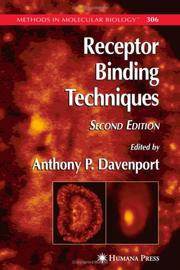
ISBN: 1280359056 9786610359059 1592599273 158829420X Year: 2005 Publisher: Totowa, N.J. : Humana Press,
Abstract | Keywords | Export | Availability | Bookmark
 Loading...
Loading...Choose an application
- Reference Manager
- EndNote
- RefWorks (Direct export to RefWorks)
Maintaining the high standards set by the successful first edition, Anthony P. Davenport and a panel of hands-on researchers from the pharmaceutical industry and academia take advantage of the latest developments to provide detailed practical methods for studying receptors in silico, in vitro, and in vivo. These readily reproducible techniques cover mining from curated databases, identifying novel receptors by high throughput screening, molecular methods to identify mRNA encoding receptors, radioligand binding assays and their analysis, quantitative autoradiography, and imaging receptors by positron emission tomography (PET). Highlights include phenotypic characterization of receptors in knock-out mice, imaging receptors using green fluorescent protein and fluorescent resonance energy transfer, and quantitative analysis of receptor mRNA by TaqMan polymerase chain reaction (PCR). These ligand binding techniques are perfect for exploring the unprecedented number of new receptor systems now emerging and the so-called "orphan" receptors whose activating ligand has not been identified. The protocols follow the successful Methods in Molecular Biology™ series format, each offering step-by-step laboratory instructions, an introduction outlining the principle behind the technique, lists of the necessary equipment and reagents, and tips on troubleshooting and avoiding known pitfalls. Comprehensive and state of the art, Receptor Binding Techniques, Second Edition offers academic and commercial researchers in the pharmaceutical and biotechnology industries a set of proven techniques for the successful characterization of receptors and the phenotyping of transgenic animals, including knock-outs.
Pharmacy. --- Chemistry --- Medicine --- Drugs --- Materia medica --- Pharmacology --- Receptor-ligand complexes --- Radioligand assay --- Cell receptors --- Research
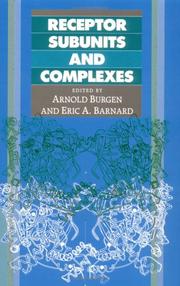
ISBN: 0521366127 Year: 1992 Publisher: Cambridge : Cambridge University Press,
Abstract | Keywords | Export | Availability | Bookmark
 Loading...
Loading...Choose an application
- Reference Manager
- EndNote
- RefWorks (Direct export to RefWorks)
Ligands. --- Receptors, Cell Surface --- Cell receptors --- Receptor-ligand complexes --- Complexes récepteur-ligand --- physiology. --- Structure-activity relationships
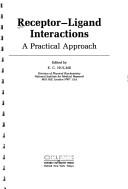
ISBN: 0199630909 0199630917 Year: 1992 Publisher: Oxford,New York : IRL Press,
Abstract | Keywords | Export | Availability | Bookmark
 Loading...
Loading...Choose an application
- Reference Manager
- EndNote
- RefWorks (Direct export to RefWorks)
Ligands --- Radioligand Assay --- Signal Transduction --- Cell receptors --- Drug receptors --- Ligand binding (Biochemistry) --- Radioligand assay --- Receptor-ligand complexes --- Ligands (Biochimie) --- Complexes récepteur-ligand --- methods --- Research --- Methodology --- Fixation --- Radioligand assay. --- Receptor-ligand complexes. --- Methodology. --- Ligand binding (Biochemistry). --- Complexes récepteur-ligand --- Ligands. --- Signal Transduction. --- methods.
Book
ISBN: 364219544X 3642195458 Year: 2011 Publisher: Berlin ; Heidelberg : Springer-Verlag,
Abstract | Keywords | Export | Availability | Bookmark
 Loading...
Loading...Choose an application
- Reference Manager
- EndNote
- RefWorks (Direct export to RefWorks)
Adaptive immune responses serve as a key defense mechanism for the control of infections in vertebrates. Immune responses must be of sufficient strength to contain invading pathogens, antigen specific responses require regulatory mechanisms to ensure termination or downmodulation to avoid excessive damage to the host tissue. For both branches of the adaptive immune system, regulatory molecules i.e. coreceptors and ligands have been identified that control the signaling cascades initiated by engagement of the T cell and B cell antigen receptors. This book describes biological functions as well as molecular mechanisms of these molecules. Fc Receptor-Like molecules (FCRL) that have garnered increasing interest due to their differential patterns of lymphocyte expression and potential involvement in the pathogenesis of autoimmune disorders, immunodeficiency and lymphoid malignancies in humans. Programmed cell death-1 (PD-1) delivers negative signals upon interaction with its two ligands, PD-L1 or PD-L2. The biological significance of PD-1 and its ligand suggest the therapeutic potential of manipulation of PD-1 pathway against various human diseases. TIM-3 acts as a negative regulator of Th1/Tc1 cell function by triggering cell death upon interaction with its ligand, galectin-9. This negative regulatory function of TIM-3 has now been expanded to include its involvement in establishing and/or maintaining a state of T cell dysfunction or ‘exhaustion’ observed in chronic viral diseases. The Ly49 receptors, which are expressed in a stochastic manner on subsets of murine Natural Killer (NK) cells, T cells, and other cells, are encoded by the Klra gene family and include receptors with either inhibitory or activating function. Most of the inhibitory Ly49 receptors recognize polymorphic epitopes on major histocompatibility complex (MHC) class I proteins as ligands. Fc-receptors for IgG (FcRs) are widely expressed on innate immune effector cells in mediating the protective function of IgG. This book discusses how the interaction of these different ligands to classical and novel Fc-receptors influences the immune response and which strategies microorganisms have developed to prevent them. The host derived cytokine IL-10 is a key player in the establishment and perpetuation of viral persistence. This book covers the role of IL-10 in viral persistence and explores the exciting prospect of therapeutically blocking IL-10 to increase antiviral immunity and vaccine efficacy. TGF-ß inhibits the proliferation of T cells as well as cytokine production via Foxp3-dependent and independent mechanisms. Recent studies suggest that Smad2 as well as Smad3 play essential roles in Foxp3 induction and cytokine suppression, whereas Th17 differentiation is promoted via the Smad-independent pathway. Mutual suppression of signaling between TGF-ß and inflammatory cytokines has been shown to be necessary for the balance of immunity and tolerance.
Immunology. --- Microbiology. --- Receptor-ligand complexes. --- Immune response --- Laboratory Chemicals --- Membrane Proteins --- Proteins --- Specialty Uses of Chemicals --- Chemical Actions and Uses --- Amino Acids, Peptides, and Proteins --- Chemicals and Drugs --- Receptors, Cell Surface --- Ligands --- Biology --- Health & Biological Sciences --- Microbiology & Immunology --- Microbial biology --- Ligand-receptor complexes --- Receptor complexes (Biochemistry) --- Medicine. --- Biomedicine. --- Immunobiology --- Life sciences --- Serology --- Clinical sciences --- Medical profession --- Human biology --- Medical sciences --- Pathology --- Physicians --- Microorganisms --- Cell receptors --- Ligand binding (Biochemistry)
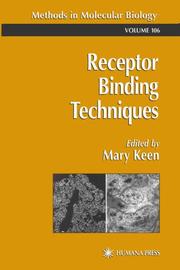
ISBN: 0896035301 1592595790 Year: 1999 Publisher: Totowa, NJ : Humana Press : Imprint: Humana,
Abstract | Keywords | Export | Availability | Bookmark
 Loading...
Loading...Choose an application
- Reference Manager
- EndNote
- RefWorks (Direct export to RefWorks)
In Receptor Binding Techniques, detailed experimental protocols devised by expert practitioners demonstrate the power of radioligand binding for studying a wide variety of receptors. The methods can be applied to G protein-coupled receptors, receptors with integral ion channels, and sites other than receptors, such as guanine nucleotide binding proteins, enzymes, transporters, and mRNA. The individual protocols encompass many different preparations, ranging from solubilized receptors, through membrane preparations, intact cells, and autoradiography in tissue slices, to PET and SPECT analysis of binding in living human brain. Along with the detailed, easily reproducible instructions, the protocols also take into account the problems inherent in the basic binding technique, such as common experimental artifacts and the definition of receptor sites, as well as problems associated with the use of particular ligands and receptor preparations. Receptor Binding Techniques shows clearly how these techniques can be adapted to many different applications and fully utilized in drug discovery programs. It will be of high value not only to researchers new to the field of receptor binding, but also to more experienced workers, serving as an authoritative bench manual replete with optimalized practical methods and protocols. Pharmacologists, neuroscientists, cell biologists, molecular biologists, and biochemists.
Receptor-ligand complexes --- Radioligand assay --- Cell receptors --- Radioligand Assay --- Methods --- Receptors, Drug --- Binding Sites --- Diagnostic Techniques, Endocrine --- Investigative Techniques --- Laboratory Techniques and Procedures --- Molecular Structure --- Diagnostic Techniques, Radioisotope --- Proteins --- Analytical, Diagnostic and Therapeutic Techniques and Equipment --- Diagnostic Techniques and Procedures --- Amino Acids, Peptides, and Proteins --- Biochemical Phenomena --- Diagnosis --- Chemical Phenomena --- Chemicals and Drugs --- Phenomena and Processes --- Cytology --- Biology --- Health & Biological Sciences --- Laboaratory manuals --- Research --- Laboratory manuals --- Binding Sites. --- Laboratory manuals. --- Laboaratory manuals. --- methods. --- isolation & purification. --- Methods. --- Isolation & purification. --- Medicine. --- Pharmacology. --- Biomedicine. --- Pharmacology/Toxicology. --- Drug effects --- Medical pharmacology --- Medical sciences --- Chemicals --- Chemotherapy --- Drugs --- Pharmacy --- Clinical sciences --- Medical profession --- Human biology --- Life sciences --- Pathology --- Physicians --- Physiological effect --- Toxicology. --- Medicine --- Pharmacology --- Poisoning --- Poisons --- Toxicology
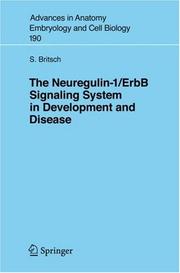
ISBN: 1280853654 9786610853656 3540371079 3540371052 Year: 2007 Publisher: Berlin ; New York : Springer,
Abstract | Keywords | Export | Availability | Bookmark
 Loading...
Loading...Choose an application
- Reference Manager
- EndNote
- RefWorks (Direct export to RefWorks)
Neuregulins are EGF-like growth and differentiation factors that interact with tyrosine kinase receptors of the ErbB family. this signailing system has a wide range of functions during development of the nervous system, the heart, and the mammary gland. Furthermore, Neuregulin signals are also involved in the development of human diseases including breast cancer, heart disease and the pathogenesis of schizophrenia. This monograph reviews the biology of Neuregulins and their receptors and summarizes recent research, which has established crucial functions of this signaling system during development and disease. .
Embryology. --- Cell interaction. --- Receptor-ligand complexes. --- Growth factors. --- Ligand-receptor complexes --- Receptor complexes (Biochemistry) --- Cell receptors --- Ligand binding (Biochemistry) --- Cell-cell interaction --- Cell communication --- Cellular communication (Biology) --- Cellular interaction --- Intercellular communication --- Cellular control mechanisms --- Animal embryology --- Animals --- Development, Embryological --- Development, Embryonic --- Development, Zygotic --- Embryogenesis --- Embryogeny --- Embryological development --- Embryonic development --- Zoology --- Zygote development --- Zygotes --- Zygotic development --- Zygotic embryogenesis --- Developmental biology --- Morphology (Animals) --- Embryos --- Reproduction --- Cell growth factors --- Cellular growth factors --- Growth peptides --- Growth promoting substances --- Growth substances --- Peptide growth factors --- Peptide regulatory factors --- Polypeptide growth factors --- Cytokines --- Peptides --- Embryology --- Development --- Medicine. --- Molecular Medicine. --- Clinical sciences --- Medical profession --- Human biology --- Life sciences --- Medical sciences --- Pathology --- Physicians --- Health Workforce --- Molecular biology. --- Molecular biochemistry --- Molecular biophysics --- Biochemistry --- Biophysics --- Biomolecules --- Systems biology --- Medicine --- Biology --- Biomedical Research. --- Research. --- Biological research --- Biomedical research
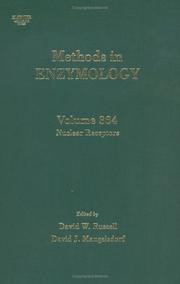
ISSN: 00766879 ISBN: 0121822672 9786611011369 1281011363 0080497071 9780121822675 Year: 2003 Volume: 364 Publisher: Amsterdam Elsevier Academic Press
Abstract | Keywords | Export | Availability | Bookmark
 Loading...
Loading...Choose an application
- Reference Manager
- EndNote
- RefWorks (Direct export to RefWorks)
Nuclear Receptors are inducible transcription factors that mediate complex effects on development, differentiation and homeostasis. They regulate the transcription of their target genes through binding to DNA sequences.*Analysis of Nuclear Receptor Ligands*Structure/Function Analysis of Nuclear Receptors*Analysis of Nuclear Receptor Co-Factors and Chromatin Remodeling
Nuclear receptors (Biochemistry). --- Laboratory Chemicals --- Proteins --- DNA-Binding Proteins --- Investigative Techniques --- Transcription Factors --- Biochemical Phenomena --- Pharmacological Phenomena --- Physiological Phenomena --- Analytical, Diagnostic and Therapeutic Techniques and Equipment --- Amino Acids, Peptides, and Proteins --- Specialty Uses of Chemicals --- Chemical Phenomena --- Phenomena and Processes --- Chemical Actions and Uses --- Chemicals and Drugs --- Receptors, Cytoplasmic and Nuclear --- Structure-Activity Relationship --- Models, Animal --- Ligands --- Human Anatomy & Physiology --- Health & Biological Sciences --- Animal Biochemistry --- Experimental Animal Models --- Laboratory Animal Models --- Animal Model --- Animal Model, Experimental --- Animal Model, Laboratory --- Animal Models --- Animal Models, Experimental --- Animal Models, Laboratory --- Experimental Animal Model --- Laboratory Animal Model --- Model, Animal --- Model, Experimental Animal --- Model, Laboratory Animal --- Models, Experimental Animal --- Models, Laboratory Animal --- Animal Experimentation --- Relationship, Structure-Activity --- Relationships, Structure-Activity --- Structure Activity Relationship --- Structure-Activity Relationships --- Cytoplasmic Hormone Receptors --- Cytoplasmic Receptors --- Cytosol and Nuclear Receptors --- Intracellular Membrane Receptors --- Nuclear Hormone Receptors --- Nuclear Receptors --- Receptors, Cytoplasmic --- Receptors, Cytosol and Nuclear --- Receptors, Cytosolic and Nuclear --- Receptors, Intracellular Membrane --- Receptors, Nuclear --- Receptors, Nuclear and Cytoplasmic --- Cytoplasmic and Nuclear Receptors --- Cytosolic and Nuclear Receptors --- Hormone Receptors, Cytoplasmic --- Hormone Receptors, Nuclear --- Nuclear and Cytoplasmic Receptors --- Membrane Receptors, Intracellular --- Receptors, Cytoplasmic Hormone --- Receptors, Nuclear Hormone --- Hormones --- Chemical Phenomenon --- Chemical Process --- Physical Chemistry Phenomena --- Physical Chemistry Process --- Physicochemical Phenomenon --- Physicochemical Process --- Chemical Concepts --- Chemical Processes --- Physical Chemistry Concepts --- Physical Chemistry Processes --- Physicochemical Concepts --- Physicochemical Phenomena --- Physicochemical Processes --- Chemical Concept --- Chemistry Process, Physical --- Chemistry Processes, Physical --- Concept, Chemical --- Concept, Physical Chemistry --- Concept, Physicochemical --- Concepts, Chemical --- Concepts, Physical Chemistry --- Concepts, Physicochemical --- Phenomena, Chemical --- Phenomena, Physical Chemistry --- Phenomena, Physicochemical --- Phenomenon, Chemical --- Phenomenon, Physicochemical --- Physical Chemistry Concept --- Physicochemical Concept --- Process, Chemical --- Process, Physical Chemistry --- Process, Physicochemical --- Processes, Chemical --- Processes, Physical Chemistry --- Processes, Physicochemical --- Specialty Chemicals and Products --- Physiological Concepts --- Physiological Phenomenon --- Physiological Process --- Physiological Processes --- Concept, Physiological --- Concepts, Physiological --- Phenomena, Physiological --- Phenomenas, Physiological --- Phenomenon, Physiological --- Physiological Concept --- Process, Physiological --- Processes, Physiological --- Pharmacologic Phenomena --- Pharmacologic Phenomenon --- Pharmacologic Process --- Pharmacological Concepts --- Pharmacological Phenomenon --- Pharmacologic Processes --- Pharmacological Processes --- Concept, Pharmacological --- Concepts, Pharmacological --- Pharmacological Concept --- Phenomena, Pharmacologic --- Phenomena, Pharmacological --- Phenomenon, Pharmacologic --- Phenomenon, Pharmacological --- Process, Pharmacologic --- Processes, Pharmacologic --- Processes, Pharmacological --- Biochemical Concepts --- Biochemical Phenomenon --- Biochemical Process --- Phenomena, Biochemical --- Biochemical Processes --- Biochemical Concept --- Concept, Biochemical --- Concepts, Biochemical --- Phenomenon, Biochemical --- Process, Biochemical --- Processes, Biochemical --- Molecular Biology --- Transcription Factor --- Factor, Transcription --- Factors, Transcription --- Gene Expression Regulation --- Transcription, Genetic --- Investigative Technics --- Investigative Technic --- Investigative Technique --- Technic, Investigative --- Technics, Investigative --- Technique, Investigative --- Techniques, Investigative --- DNA Binding Protein --- DNA Single-Stranded Binding Protein --- SS DNA BP --- Single-Stranded DNA-Binding Protein --- DNA Helix Destabilizing Proteins --- Single-Stranded DNA Binding Proteins --- Binding Protein, DNA --- DNA Binding Proteins --- DNA Single Stranded Binding Protein --- DNA-Binding Protein, Single-Stranded --- Single Stranded DNA Binding Protein --- Single Stranded DNA Binding Proteins --- Gene Products, Protein --- Gene Proteins --- Protein Gene Products --- Proteins, Gene --- Molecular Mechanisms of Pharmacological Action --- Chemicals, Laboratory --- Ligand --- Cytoplasmic Receptor --- Nuclear Hormone Receptor --- Nuclear Receptor --- Hormone Receptor, Nuclear --- Receptor, Cytoplasmic --- Receptor, Nuclear --- Receptor, Nuclear Hormone --- DNA-Binding Protein --- Protein, DNA-Binding --- Protein --- Hormone receptors. --- Nuclear receptors (Biochemistry) --- Receptor-ligand complexes.
| Listing 1 - 8 of 8 |
Sort by
|

 Search
Search Feedback
Feedback About UniCat
About UniCat  Help
Help News
News